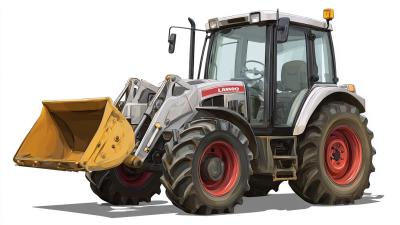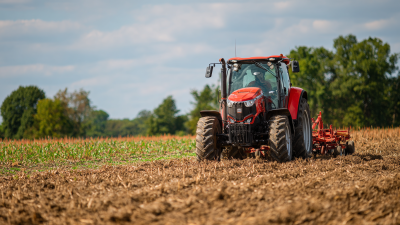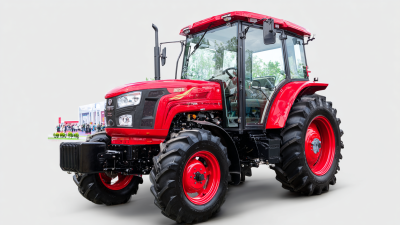When it comes to agricultural and landscaping tasks, choosing the right equipment can significantly enhance productivity and efficiency. Among the various options available, the small front loader tractor has emerged as a popular choice for both small-scale farmers and homeowners. According to the Agricultural Equipment Market Report 2022, the demand for compact tractors, which include small front loader tractors, has grown by over 15% in recent years due to their versatility and maneuverability in tight spaces. This increase in popularity highlights the importance of selecting the right model to meet specific operational needs.
Small front loader tractors are designed to handle a variety of tasks, from digging and hauling to lifting and carrying materials. They are particularly advantageous in residential projects and small farms where larger equipment may be impractical. A report by the Equipment Dealers Association indicates that over 60% of small to medium-sized farms prefer compact machinery for their flexibility and ease of use, making small front loader tractors an essential part of modern agricultural practices. Understanding the features and functionalities of these machines is crucial for users looking to optimize their performance and achieve excellent results.

When selecting the best small front loader tractor for your farm, several key factors should guide your decision. Firstly, assess the size and layout of your land. A smaller tractor is ideal for navigating tight spaces, such as between rows of crops or around farm buildings. Consider the horsepower and lifting capacity required for your tasks, as larger loads may necessitate a more powerful engine and robust loader design. Pay attention to the tractor's weight distribution as well; a well-balanced tractor enhances stability, especially when performing heavy lifting.
Another crucial factor is the type of attachments compatible with the tractor. Front loader tractors are versatile, often designed to accommodate a range of implements like buckets, forks, and grapples. Ensure the model you choose supports the attachments you'll need for your specific farm operations. Additionally, consider the ease of maintenance and availability of parts for your tractor brand, as this can influence the long-term viability and performance of the equipment. Ultimately, making an informed choice involves understanding your operational needs, the tractor’s capabilities, and the ongoing support available for that machinery.
When selecting a small front loader tractor, understanding engine power and fuel efficiency is crucial. The market for these tractors is divided based on power output, typically categorized into segments such as less than 100 hp, 101-200 hp, 201-400 hp, and above 400 hp. Tractors in the 101-200 hp range often strike a balance between power and fuel economy, making them popular for both agricultural and construction applications. This segment is particularly appealing to users who require sufficient power for demanding tasks without the higher operational costs associated with tractors in the larger horsepower brackets.
Fuel efficiency varies significantly among different power categories. Smaller tractors under 100 hp are generally more fuel-efficient, ideal for light-duty tasks on small to medium-sized farms. However, as power increases, the fuel consumption tends to rise, which can impact total operational costs. Buyers should carefully evaluate their specific needs, including the types of tasks they intend to perform and the size of their land, to select a model that provides the best combination of power and efficiency for their operational goals.
This chart presents a comparative analysis of engine power (in horsepower) and fuel efficiency (in miles per gallon) for various small front loader tractors. This information could assist potential buyers in making informed decisions based on their specific needs.
When selecting a small front loader tractor, understanding load capacity is crucial for maximizing its performance and suitability for various tasks. Load capacity refers to the maximum weight a tractor can safely handle, which includes the weight of implements, materials, and any additional load. A tractor with a higher load capacity will perform better in heavy-duty tasks such as hauling dirt, lifting bales, or moving large rocks, while a lower capacity may be more suited for light landscaping tasks or garden maintenance.
Choosing the appropriate load capacity involves assessing the specific tasks you plan to undertake. For tasks that require heavy lifting or transport, such as farm operations or construction, selecting a tractor with a higher load capacity will ensure efficiency and safety. Conversely, if your needs are primarily for light work, such as snow removal or maintaining a small estate, a smaller capacity tractor will likely suffice. Ultimately, understanding load capacity will help you make a more informed decision, ensuring your tractor meets your requirements and enhances your productivity.
| Model | Load Capacity (lbs) | Engine Power (HP) | Hydraulic Lift Capacity (lbs) | Weight (lbs) | Best Use |
|---|---|---|---|---|---|
| Model A | 1200 | 25 | 1000 | 2300 | Landscaping |
| Model B | 1400 | 30 | 1200 | 2500 | Farming |
| Model C | 1600 | 35 | 1400 | 2700 | Construction |
| Model D | 1800 | 40 | 1600 | 2900 | Forestry |
When selecting a small front loader tractor, buyers should prioritize key features that enhance performance and usability. According to the latest reports by industry experts, such as the Agricultural Equipment Manufacturers Association, tractors equipped with a reliable hydraulic system can significantly increase productivity. Specifically, tractors with a hydraulic lift capacity exceeding 1,500 pounds allow for efficient handling of various loads, making them indispensable for small farms and landscaping operations.
Another crucial feature to consider is the tractor's compactness and maneuverability. Data from the American Society of Agricultural and Biological Engineers indicates that small front loader tractors with a wheelbase under 60 inches provide optimal turning radius, which is essential for navigating tight spaces on small properties. Furthermore, advanced features such as a comfortable control layout and ergonomic seating have been linked to increased operator efficiency, reducing fatigue during long hours of operation. Investing in these features can lead to long-term benefits and improved performance for any task at hand.
As we look into 2023, the small front loader tractor market is experiencing significant transformations driven by technological advancements and changing consumer needs. One of the pivotal trends is the integration of smart technology, which enhances operational efficiency. Many manufacturers are now incorporating GPS systems and telematics into their tractors, allowing users to monitor performance data in real-time and optimize their farming practices. This not only increases productivity but also aids in minimizing operational costs.
Additionally, sustainability has become a central theme within the industry. Many companies are focusing on developing eco-friendly models that reduce emissions and improve fuel efficiency. Innovations such as electric or hybrid front loaders are gaining traction, appealing to environmentally conscious consumers who prioritize sustainability in their purchasing decisions. These developments reflect the industry's commitment to not only meeting the demands of modern agribusiness but also contributing to a greener future.
Thus, 2023 is poised to be a pivotal year for small front loader tractors, intertwining technology and sustainability in response to current market trends.





